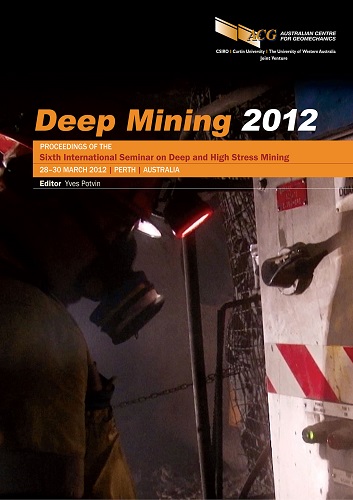High-resolution fracture recognition from seismic data ‒ applying oil and gas technology to mining

|
Authors: Oppermann, RHJ |
DOI https://doi.org/10.36487/ACG_rep/1201_18_oppermann
Cite As:
Oppermann, RHJ 2012, 'High-resolution fracture recognition from seismic data ‒ applying oil and gas technology to mining', in Y Potvin (ed.), Deep Mining 2012: Proceedings of the Sixth International Seminar on Deep and High Stress Mining, Australian Centre for Geomechanics, Perth, pp. 247-255, https://doi.org/10.36487/ACG_rep/1201_18_oppermann
Abstract:
During the last two decades, volume interpretation techniques have revolutionised traditional 3D seismic interpretation workflows in the oil and gas industry. While traditional interpretation mainly relies on an interpreter to work through a large volume of data to identify and manually characterise subsurface geology and resources, volume interpretation allows to filter and classify subsurface features and extract 3D geological information through automated processes at a much faster pace, with higher accuracy and at higher resolution. This paper presents innovative techniques and workflows in structural volume interpretation that have been developed and proven extremely successful in oil and gas projects. More recently, this technology has been applied to mining projects. The workflows integrate highest-resolution, automated fracture network mapping results from 3D seismic data with the detailed calibration and review of various drilling, mining and production data, allowing to delineate fluid barriers, fluid conduits, fault-related mineralisations or drilling and mining hazards in the subsurface. From this, groundbreaking insights can be gained into the 3D distribution of fracture networks, and how these can affect drilling and mining activities and the production of resources. Examples from oil and gas and mining projects around the world demonstrate that these new techniques can provide a step-change in understanding drilling, production and safety issues in existing wells or mines. Furthermore, they can be utilised to optimise future resource activities and recoveries, and increase the safety of future operations. Automated fracture extraction techniques challenge widespread perceptions of what is seismically resolvable from 3D seismic data. Fault and fracture networks can not only be identified faster and more reliably, but also at a much higher resolution than achieved by other current seismic methods. With the increased resolution, much greater fault/fracture densities are identified than previously mapped or recognised, and a better understanding of structural geometries and fault populations can be gained. A focused application of the new technology workflows can deliver increased recoveries from resources. It can also result in safer, cheaper and more successful drilling and mining operations. As such, these new techniques are proposed as Best Practice tools for both mining and oil and gas resource development planning and execution.
References:
Admasu, F., Back, S. and Toennies, K. (2006) Autotracking of faults on 3D seismic data, Geophysics, Vol. 71, No. 6, pp. A49–A53.
Antonellini, M. and Aydin, A. (1994) Effect of faulting on fluid flow in porous sandstones: petrophysical properties, AAPG Bulletin - American Association of Petroleum Geologists, Vol. 78, pp. 355–377.
Chopra, S. and Marfurt, K.J. (2007) Volumetric curvature attributes add value to 3D seismic data interpretation, The Leading Edge, July 2007, pp. 856–867.
Cocker, J., Urosevic, M. and Evans, B. (1997) A high resolution seismic survey to assist in mine planning, in Proceedings Exploration 97: Fourth Decennial International Conference on Mineral Exploration, A.G. Gubins (ed), pp. 473–476.
Gochioco, L.M. and Cotten, S.A. (1989) Locating faults in underground coal mines using high-resolution seismic reflection techniques, Geophysics, Vol. 54, No. 12, pp. 1521–1527.
Hoecker, C. and Fehmers, G. (2002) Fast structural interpretation with structure-oriented filtering, The Leading Edge, March 2002, pp. 238–243.
Lonergan, L., Jolly, R.J.H., Rawnsley, K. and Sanderson, D.J. (2007) Fractured Reservoirs, Geological Society of London Special Publication 270, published 15 March 2007, L. Lonergan (author, editor), R.J.H. Jolly, K. Rawnsley, D.J. Sanderson (eds), 296 pages, ISBN-13: 978-1862392137.
Maerten, L., Gillespie, P. and Daniel, J-M. (2006) Three-dimensional geomechanical modeling for constraint of subseismic fault simulation, AAPG Bulletin, Vol. 90, No. 9, pp. 1337–1358.
Molinda, M. and Ingram, D.K. (1990) Effects of structural faults on ground control in selected coal mines in southwest Virginia, International Journal of Mining and Geological Engineering, Vol. 8, pp. 332–347.
Nelson, R.A. (2001) Geologic analysis of naturally fractured reservoirs, Elsevier Inc., 2nd edition.
Oppermann, R. (2010) A new method for high-resolution fault imaging delivers groundbreaking insights into drilling and production of resources, ASEG 21st International Geophysical Conference and Exhibition, Extended Abstract, Sydney.
Pepper, R. and Bejarano, G. (2005) Advances in seismic fault interpretation automation, Search and Discovery Article, #40169, pp. 1–16.
Peters, T. and Hearn, S. (2001) The influence of coal-mine geology on seismic data quality in the Bowen Basin, in Extended Abstracts, ASEG 15th Geophysical Conference and Exhibition, August 2001, Brisbane.
Stephenson, B., Cassidy, P. and Warrlich, G. (2005) Novel use of seismic volume interpretation for fracture detection and modeling: examples from field in the Philippines and the Middle East, 14th SPE Middle East Oil and Gas Show and Conference, Bahrain, 12–15 March 2005, SPE 93759.
© Copyright 2025, Australian Centre for Geomechanics (ACG), The University of Western Australia. All rights reserved.
View copyright/legal information
Please direct any queries or error reports to repository-acg@uwa.edu.au
View copyright/legal information
Please direct any queries or error reports to repository-acg@uwa.edu.au